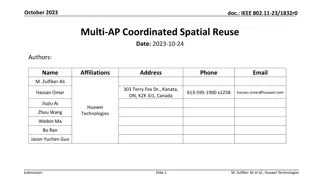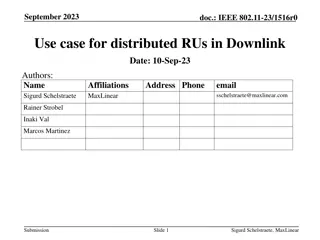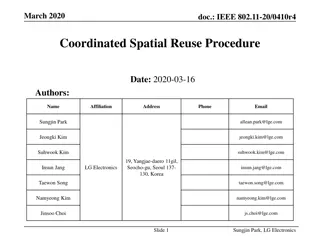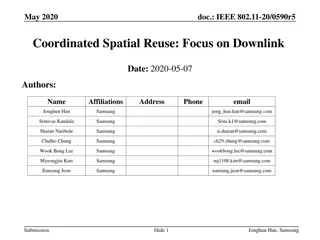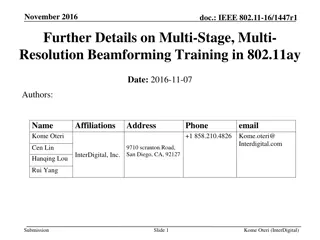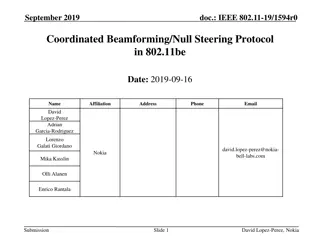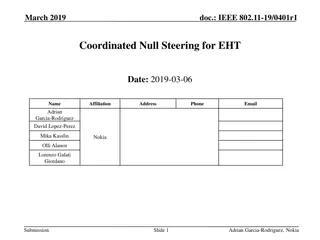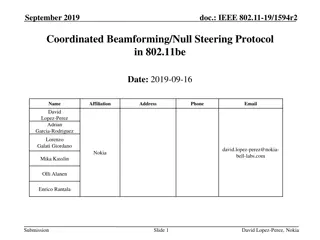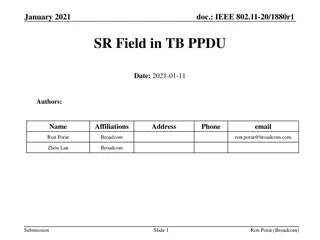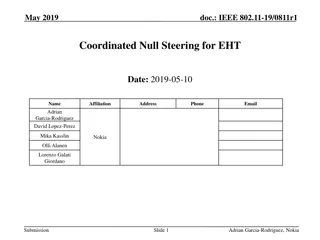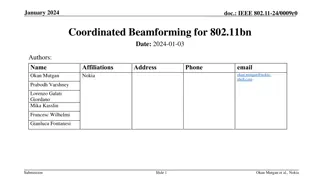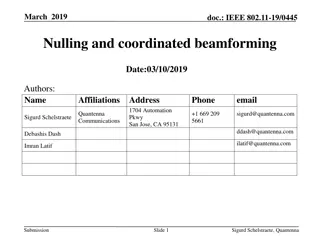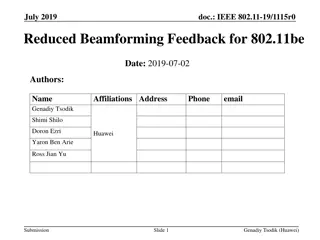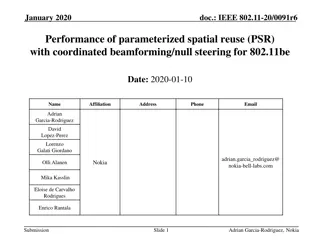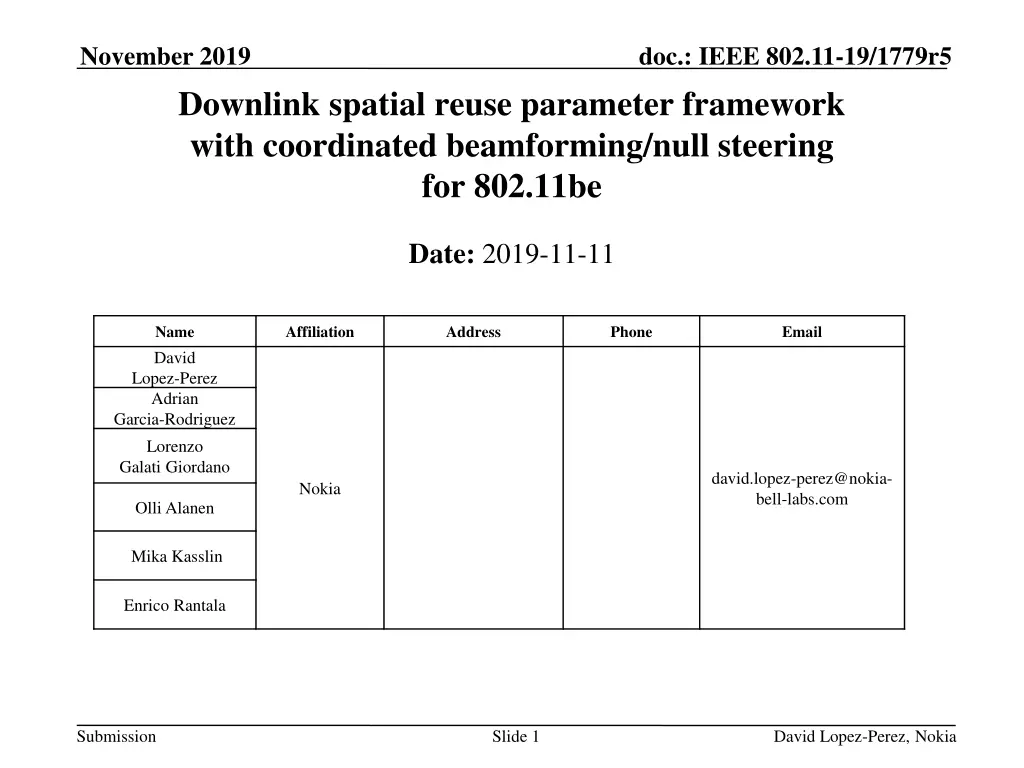
Spatial Reuse Parameter Framework for Coordinated Beamforming in IEEE 802.11be
Explore the innovative spatial reuse parameter framework introduced in IEEE 802.11-19/1779r5 for coordinated beamforming with null steering in the downlink transmission setting. This framework extends the uplink-centric approach of 802.11ax to enhance coordinated beamforming capabilities, providing an altruistic sharing mechanism for transmission opportunities among access points and inter-BSS devices. Dive into the details of this framework and its potential implications for efficient wireless communication systems.
Download Presentation

Please find below an Image/Link to download the presentation.
The content on the website is provided AS IS for your information and personal use only. It may not be sold, licensed, or shared on other websites without obtaining consent from the author. If you encounter any issues during the download, it is possible that the publisher has removed the file from their server.
You are allowed to download the files provided on this website for personal or commercial use, subject to the condition that they are used lawfully. All files are the property of their respective owners.
The content on the website is provided AS IS for your information and personal use only. It may not be sold, licensed, or shared on other websites without obtaining consent from the author.
E N D
Presentation Transcript
November 2019 doc.: IEEE 802.11-19/1779r5 Downlink spatial reuse parameter framework with coordinated beamforming/null steering for 802.11be Date: 2019-11-11 Authors: Name David Lopez-Perez Adrian Garcia-Rodriguez Lorenzo Galati Giordano Affiliation Address Phone Email david.lopez-perez@nokia- bell-labs.com Nokia Olli Alanen Mika Kasslin Enrico Rantala Submission Slide 1 David Lopez-Perez, Nokia
November 2019 doc.: IEEE 802.11-19/1779r5 Introduction The 802.11ax spatial reuse parameter (SRP) framework is uplink-centric SRP allows APs to altruistically but coordinately share an uplink transmission opportunity (TXOP) with other inter-BSS devices As shown in [1594r2], SRP also provides a good basis for coordinated beamforming/null steering In this contribution, we review the SRP framework with coordinated beamforming/null steering of [1594r2], propose an extension of the uplink-centric SRP framework of 802.11ax to the downlink, and sketch how coordinated beamforming/null steering can take advantage of it Submission Slide 2 David Lopez-Perez, Nokia
November 2019 doc.: IEEE 802.11-19/1779r5 Uplink 802.11ax SRP Framework Enables spatial reuse during uplink transmissions Standard version 1. AP1 advertises the spatial reuse opportunity (SRO) in a trigger frame (TF), and provides information about AP1 transmit power AP1 acceptable uplink interference level Data transmission TF advertises SRO ACK TF UL data reception donor AP1 BSS1 UL data STA11 2. STA21 measures AP1 received power level, and determines whether using the SRO STA21 derives, e.g. its maximum transmit power, based on the above information UL data STA12 ACK UL data reception AP2 Contention BSS2 UL data (constrained TX power) t STA21 STA21 measures power, and identifies a spatial reuse opportunity 3. If STA21 finds an SRO, it contends while AP1 is receiving uplink data STA21 TXOP has to accommodate all transmissions within AP1 data reception Submission Slide 3 David Lopez-Perez, Nokia
November 2019 doc.: IEEE 802.11-19/1779r5 Uplink 802.11ax SRP framework Good basis for coordinated beamforming/null steering Standard version + coordinated null steering support (see [1594r2]) Phase 1 Coord. Phase 2 Implicit CSI acquisition Phase 3 Coordinated inter-AP DATA TX & ACK with nulls Data transmission Null steering TF advertises spatial reuse opportunity AP1 nulls STA21 TF ACK UL data reception CRequest NDPA TF NDP NDP donor AP1 BSS1 NDP UL data NDP STA11 NDP UL data STA12 AP2 nulls STAs 11 and 12 ACK TF UL data reception NDP CResponse AP2 Contention BSS2 NDP UL data NDP STA21 t STA21 measures power, and identifies a spatial reuse opportunity Transfer and return frames may be needed to coordinate AP1 and AP2 actions *Similar to 802.11ax, an alternative implementation could be based on AP2 sending the ACK while AP1 is still performing UL data reception Submission Slide 4 David Lopez-Perez, Nokia
November 2019 doc.: IEEE 802.11-19/1779r5 Uplink 802.11ax SRP framework Need for extending this framework to the downlink 802.11ax SRP does not extend its operation to the downlink Two major missed opportunities: In contrast to the uplink, APs cannot altruistically but coordinately share a downlink TXOP with other inter-BSS devices This results in wasted spatial reuse opportunities More importantly, we cannot provide a straightforward extension for downlink coordinated beamforming/null steering In the following, we propose a downlink SRP framework to address both shortcomings, with the core objective of enabling downlink coordinated beamforming/null steering operations in 802.11be Submission Slide 5 David Lopez-Perez, Nokia
November 2019 doc.: IEEE 802.11-19/1779r5 Downlink 802.11be SRP framework Enabling spatial reuse during downlink transmissions The proposed protocol builds on is protected by an enhanced MU-RTS/CTS frame exchange, and consists of two phases: Phase 1: Improved MU-RTS to flag a downlink spatial reuse opportunity (SRO) Enhanced MU-RTS informs inter-BSS devices about a) the upcoming downlink SRO, and b) the acceptable interference level towards data-receiving STAs addressed by the MU-RTS Phase 2: New channel access rules for inter-BSS devices Upon reception of the enhanced MU-RTS frame, announcing a potential downlink SRO, inter-BSS devices do not immediately update their NAV Instead, inter-BSS devices identify channel access opportunities, where they need to adjust their transmission power based on a) the maximum tolerable level of interference specified by the MU-RTS frame, and b) the aggregate received power level (RPL) measured during the CTS response/s Submission Slide 6 David Lopez-Perez, Nokia
November 2019 doc.: IEEE 802.11-19/1779r5 Downlink 802.11be SRP framework Example Transmission Phase Phase 2 Phase 1 Donor AP1 Downlink transmission Downlink transmission MU MU- -RTS RTS BSS1 STA 21 AP2 Downlink reception (from AP1) Downlink reception (from AP1) ACK ACK CTS CTS STA 11 AP2 and STA 21 start contention AP2 gains channel access STA 22 AP1 RPL AP2 Downlink transmission (constrained TX power) Downlink transmission (constrained TX power) Downlink spatial reuse opportunity advertised measurements to estimate the strength of the potential interference link BSS2 STA 11 STA 21 ACK ACK Downlink reception (from AP2) Downlink reception (from AP2) Coverage region of AP1 [BSS1] STA 22 NAV set upon evaluating new channel access conditions. No channel access allowed NAV set upon evaluating new channel access conditions. No channel access allowed Coverage region of AP2 [BSS2] t Received power level (RPL) measurements over CTS allow inter-BSS devices to a) obtain up-to-date estimates of the potential interference towards downlink data-recipient STAs, and b) identify channel access opportunities To identify channel access opportunities, inter-BSS devices must constrain their maximum TX power according to such RPL measurements o Max TX power [dBm] SRPDL RPL [dBm], where SRPDL was provided in the MU-RTS In this example, 1) AP2 and STA 21 identify a spatial reuse opportunity, and 2) AP2 gains channel access first Submission Slide 7 David Lopez-Perez, Nokia
November 2019 doc.: IEEE 802.11-19/1779r5 Downlink 802.11be SRP framework Benefits As a result of implementing the above protocol, a safe downlink spatial reuse is enabled, and simultaneously, The AP that sent the MU-RTS (AP1 in previous example) performs a successful downlink transmission with a controlled acceptable interference level The inter-BSS APs/STAs that identified a spatial reuse opportunity (AP2 and STA 21 in the previous example) continue the countdown of an existing back-off procedure, and The inter-BSS device that gains channel access first (AP2 in the previous example) performs a concurrent transmission as long as it satisfies the power constraint set by the donor AP (AP1 in the previous example) Submission Slide 8 David Lopez-Perez, Nokia
November 2019 doc.: IEEE 802.11-19/1779r5 Coordinated null steering enhancement Downlink steering, as evaluated in e.g. [0772r1] and [1212r2], may be efficiently realized by combining the proposed downlink 802.11be SRP framework with the enhanced spatial coordination, and the CSI acquisition phases presented in [1594r2] coordinated beamforming/null STA 21 AP2 reuse opportunity STA 22 AP1 STA 11 Coverage region of AP1 [BSS1] Coverage region of AP2 [BSS2] Multi-AP coordination phase Data transmission Null steering Phase 1 Phase 2 Data transmission phase Donor AP1 RX nulls to STAs 21 and 22 TX nulls to STAs 21 and 22 Downlink transmission Downlink transmission BSS1 MU MU- -RTS RTS Enhanced spatial reuse coordination and CSI acquisition phases See [1594r2] CTS CTS Downlink reception (from AP1) Downlink reception (from AP1) ACK ACK STA 11 AP2 start contention and gains channel access TX null to STA 11 RX null to STA 11 RPL AP2 Downlink transmission Downlink transmission Downlink spatial reuse opportunity advertised measurements to estimate the strength of the potential interference link BSS2 STA 21 ACK ACK Downlink reception (from AP2) Downlink reception (from AP2) STA 22 ACK ACK Downlink reception (from AP2) Downlink reception (from AP2) t Submission Slide 9 David Lopez-Perez, Nokia
November 2019 doc.: IEEE 802.11-19/1779r5 Summary In this contribution, we have generalized the coordinated beamforming/null steering protocol of [1594r2] to the downlink To achieve that objective, we have proposed a downlink extension of the uplink-centric SRP of 802.11ax This extension relies on the utilization of MU-RTS/CTS and modified channel access conditions to guarantee safe downlink spatial reuse operations The proposed downlink SRP framework can be readily enhanced to enable an efficient implementation beamforming/null steering operations in 802.11be of coordinated Submission Slide 10 David Lopez-Perez, Nokia
November 2019 doc.: IEEE 802.11-19/1779r5 Straw poll Do you believe that coordinated beamforming/null steering is an appealing concept and should be further explored within the 802.11be task group? Yes No Abstain Submission Slide 11 David Lopez-Perez, Nokia
November 2019 doc.: IEEE 802.11-19/1779r5 References [0772r1] Roya Doostnejad (Intel), Multi-AP Collaborative BF in IEEE 802.11 , 19/0772. [1212r2] David Lopez-Perez (Nokia), Performance of Coordinated Null Steering in 802.11be , 19/1212. [1594r2] David Lopez-Perez (Nokia), Coordinated Beamforming/Null Steering in 802.11be , 19/1594. Submission Slide 12 David Lopez-Perez, Nokia

